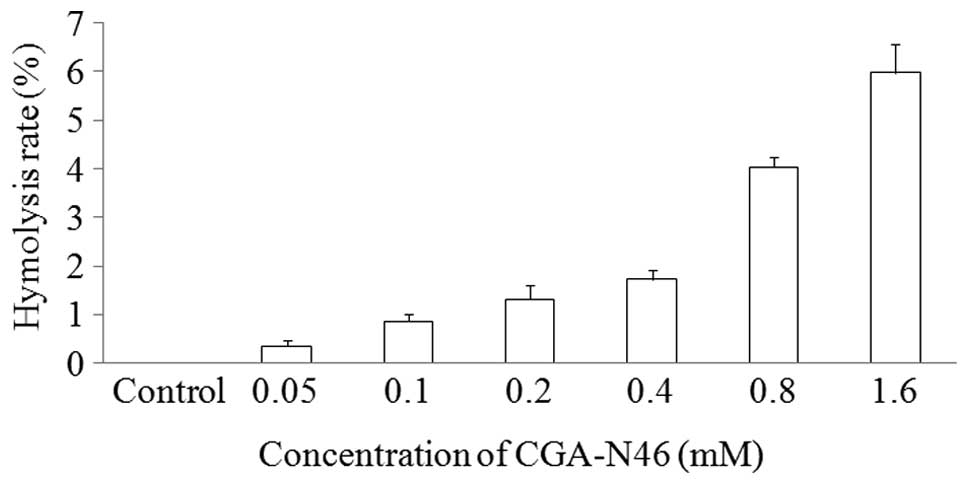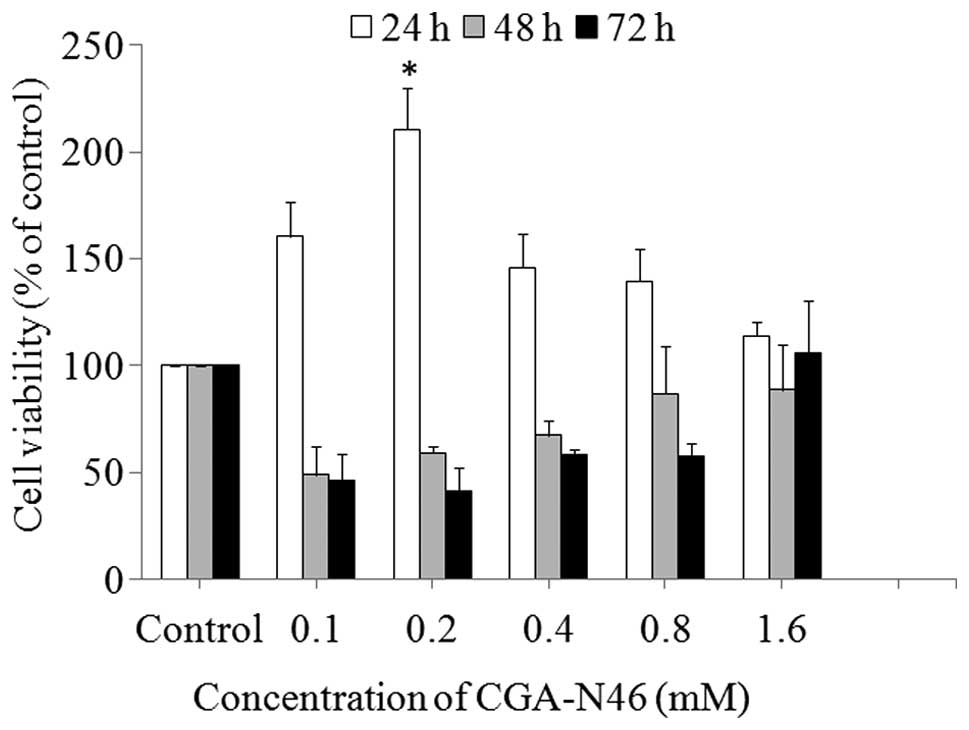|
1
|
Bassetti M, Taramasso L, Nicco E, Molinari
MP, Mussap M and Viscoli C: Epidemiology, species distribution,
antifungal susceptibility and outcome of nosocomial candidemia in a
tertiary care hospital in Italy. PLoS One. 6:e241982011. View Article : Google Scholar : PubMed/NCBI
|
|
2
|
Ortega M, Marco F, Soriano A, Almela M,
Martínez JA, López J, Pitart C and Mensa J: Candida species
bloodstream infection: Epidemiology and outcome in a single
institution from 1991 to 2008. J Hosp Infect. 77:157–161. 2011.
View Article : Google Scholar : PubMed/NCBI
|
|
3
|
Scorzoni L, de Lucas MP, Mesa-Arango AC,
Fusco-Almeida AM, Lozano E, Cuenca-Estrella M, Mendes-Giannini MJ
and Zaragoza O: Antifungal efficacy during Candida krusei
infection in non-conventional models correlates with the yeast in
vitro susceptibility profile. PLoS One. 8:e600472013. View Article : Google Scholar : PubMed/NCBI
|
|
4
|
Gudlaugsson O, Gillespie S, Lee K, Van de
Berg J, Hu J, Messer S, Herwaldt L, Pfaller M and Diekema D:
Attributable mortality of nosocomial candidemia, revisited. Clin
Infect Dis. 37:1172–1177. 2003. View
Article : Google Scholar : PubMed/NCBI
|
|
5
|
Wisplinghoff H, Bischoff T, Tallent SM,
Seifert H, Wenzel RP and Edmond MB: Nosocomial bloodstream
infections in US hospitals: Analysis of 24,179 cases from a
prospective nationwide surveillance study. Clin Infect Dis.
39:309–317. 2004. View
Article : Google Scholar : PubMed/NCBI
|
|
6
|
Pushpanathan M, Rajendhran J, Jayashree S,
Sundarakrishnan B, Jayachandran S and Gunasekaran P: Direct cell
penetration of the antifungal peptide, MMGP1, in Candida
albicans. J Pept Sci. 18:657–660. 2012. View Article : Google Scholar : PubMed/NCBI
|
|
7
|
Trick WE, Fridkin WE, Edwards SK, Hajjeh
JR, Gaynes RA and National RP: Nosocomial Infections Surveillance
System Hospitals: Secular trend of hospital-acquired candidemia
among intensive care unit patients in the United States during
1989–1999. Clin Infect Dis. 35:627–630. 2002. View Article : Google Scholar : PubMed/NCBI
|
|
8
|
Arendrup MC: Epidemiology of invasive
candidiasis. Curr Opin Crit Care. 16:445–452. 2010. View Article : Google Scholar : PubMed/NCBI
|
|
9
|
Pemán J, Cantón E, Quindós G, Eraso E,
Alcoba J, Guinea J, Merino P, Ruiz-Pérez-de-Pipaon MT,
Pérez-del-Molino L, Linares-Sicilia MJ, et al: FUNGEMYCA Study
Group; Epidemiology, species distribution and in vitro antifungal
susceptibility of fungaemia in a Spanish multicentre prospective
survey. J Antimicrob Chemother. 67:1181–1187. 2012. View Article : Google Scholar : PubMed/NCBI
|
|
10
|
Leroy O, Gangneux JP, Montravers P, Mira
JP, Gouin F, Sollet JP, Carlet J, Reynes J, Rosenheim M, Regnier B
and Lortholary O: AmarCand Study Group: Epidemiology, management
and risk factors for death of invasive Candida infections in
critical care: A multicenter, prospective, observational study in
France (2005–2006). Crit Care Med. 37:1612–1618. 2009. View Article : Google Scholar : PubMed/NCBI
|
|
11
|
Muñoz P, Sánchez-Somolinos M, Alcalá L,
Rodríguez-Créixems M, Peláez T and Bouza E: Candida krusei
fungaemia: Antifungal susceptibility and clinical presentation of
an uncommon entity during 15 years in a single general hospital. J
Antimicrob Chemother. 55:188–193. 2005. View Article : Google Scholar : PubMed/NCBI
|
|
12
|
Lata S, Mishra N and Raghava G: AntiBP2:
Improved version of antibacterial peptide prediction. BMC
Bioinformatics. 11(Suppl 1): S192010. View Article : Google Scholar : PubMed/NCBI
|
|
13
|
Lu J and Chen ZW: Isolation,
characterization and anti-cancer activity of SK84, a novel
glycine-rich antimicrobial peptide from Drosophila virilis.
Peptides. 31:44–50. 2010. View Article : Google Scholar : PubMed/NCBI
|
|
14
|
Güell I, Micaló L, Cano L, Badosa E, Ferre
R, Montesinos E, Bardají E, Feliu L and Planas M: Peptidotriazoles
with antimicrobial activity against bacterial and fungal plant
pathogens. Peptides. 33:9–17. 2012. View Article : Google Scholar : PubMed/NCBI
|
|
15
|
Hancock RE: Peptide antibiotics. Lancet.
349:418–422. 1997. View Article : Google Scholar : PubMed/NCBI
|
|
16
|
Foubister V: Superpeptide to treat
Candida albicans. Drug Discov Today. 8:380–381. 2003.
View Article : Google Scholar : PubMed/NCBI
|
|
17
|
Maisetta G, Batoni G, Esin S, Luperini F,
Pardini M, Bottai D, Florio W, Giuca MR, Gabriele M and Campa M:
Activity of human beta-defensin 3 alone or combined with other
antimicrobial agents against oral bacteria. Antimicrob Agents
Chemother. 47:3349–3351. 2003. View Article : Google Scholar : PubMed/NCBI
|
|
18
|
Eiden LE: Is chromogranin a prohormone?
Nature. 325:3011987. View
Article : Google Scholar : PubMed/NCBI
|
|
19
|
Lugardon K, Raffner R, Goumon Y, Corti A,
Delmas A, Bulet P, Aunis D and Metz-Boutigue MH: Antibacterial and
antifungal activities of vasostatin-1, the N-terminal fragment of
chromogranin A. J Biol Chem. 275:10745–10753. 2000. View Article : Google Scholar : PubMed/NCBI
|
|
20
|
Lugardon K, Chasserot-Golaz S, Kieffer AE,
Maget-Dana R, Nullans G, Kieffer B, Aunis D and Metz-Boutigue MH:
Structural and biological characterization of chromofungin, the
antifungal chromogranin A-(47–66)-derived peptide. J Biol Chem.
276:35875–35882. 2001. View Article : Google Scholar : PubMed/NCBI
|
|
21
|
Briolat J, Wu SD, Mahata SK, Gonthier B,
Bagnard D, Chasserot-Golaz S, Helle KB, Aunis D and Metz-Boutigue
MH: New antimicrobial activity for the catecholamine
release-inhibitory peptide from chromogranin A. Cell Mol Life Sci.
62:377–385. 2005. View Article : Google Scholar : PubMed/NCBI
|
|
22
|
Radek KA, Lopez-Garcia B, Hupe M, Niesman
IR, Elias PM, Taupenot L, Mahata SK, O'Connor DT and Gallo RL: The
neuroendocrine peptide catestatin is a cutaneous antimicrobial and
induced in the skin after injury. J Invest Dermatol. 128:1525–1534.
2008. View Article : Google Scholar : PubMed/NCBI
|
|
23
|
Li R, Zhang T, Luo J, Wang F, Gu Q, Gan J
and Xiao F: Antifungal activity fragments of N domain of
chromogranin A. Zhong Shan Da Xue Xue Bao. 45:64–67. 2006.(In
Chinese).
|
|
24
|
Aleinein RA, Hamoud R, Schäfer H and Wink
M: Molecular cloning and expression of ranalexin, a bioactive
antimicrobial peptide from Rana catesbeiana in Escherichia coli and
assessments of its biological activities. Appl Microbiol
Biotechnol. 97:3535–3543. 2013. View Article : Google Scholar : PubMed/NCBI
|
|
25
|
Mochon AB and Liu H: The antimicrobial
peptide histatin-5 causes a spatially restricted disruption on the
Candida albicans surface, allowing rapid entry of the peptide into
the cytoplasm. PLoS Pathog. 4:e10001902008. View Article : Google Scholar : PubMed/NCBI
|
|
26
|
Kong BW, Lee J, Bottje WG, Lassiter K, Lee
J, Gentles LE, Chandra YG and Foster DN: Microarray analysis of
early and late passage chicken embryo fibroblast cells. Poult Sci.
92:770–781. 2013. View Article : Google Scholar : PubMed/NCBI
|
|
27
|
National Committee for Clinical Laboratory
Standards (NCCLS): Reference method for broth dilution antifungal
susceptibility testing of yeasts: Approved standard (2nd). Wayne,
USA: NCCLS. 1–13. 1997.
|
|
28
|
Huang J, Hao D and Chen Y, Xu Y, Tan J,
Huang Y, Li F and Chen Y: Inhibitory effects and mechanisms of
physiological conditions on the activity of enantiomeric forms of
an α-helical antibacterial peptide against bacteria. Peptides.
32:1488–1495. 2011. View Article : Google Scholar : PubMed/NCBI
|
|
29
|
Su Y, Ma L, Wen Y, Wang H and Zhang S:
Studies of the in vitro antibacterial activities of several
polyphenols against clinical isolates of methicillin-resistant
Staphylococcus aureus. Molecules. 19:12630–12639. 2014.
View Article : Google Scholar : PubMed/NCBI
|
|
30
|
Eliopoulos GM and Moellering RC:
Antimicrobial combinations. Antibiotics in Laboratory Medicine.
Lorian V: (Baltimore, MD). Williams and Wilkins. 432–492. 1991.
|
|
31
|
Hancock RE and Diamond G: The role of
cationic antimicrobial peptides in innate host defences. Trends
Microbiol. 8:402–410. 2000. View Article : Google Scholar : PubMed/NCBI
|
|
32
|
Tlaskalová-Hogenová H, Stepánková R,
Hudcovic T, Tucková L, Cukrowska B, Lodinová-Zádníková R, Kozáková
H, Rossmann P, Bártová J, Sokol D, et al: Commensal bacteria
(normal microflora), mucosal immunity and chronic inflammatory and
autoimmune diseases. Immunol Lett. 93:97–108. 2004. View Article : Google Scholar : PubMed/NCBI
|
|
33
|
Lehmann J, Retz M, Sidhu SS, Suttmann H,
Sell M, Paulsen F, Harder J, Unteregger G and Stöckle M: Antitumor
activity of the antimicrobial peptide magainin II against bladder
cancer cell lines. Eur Urol. 50:141–147. 2006. View Article : Google Scholar : PubMed/NCBI
|
|
34
|
Wakabayashi H, Teraguchi S and Tamura Y:
Increased Staphylococcus-killing activity of an
antimicrobial peptide, lactoferricin B, with minocycline and
monoacylglycerol. Biosci Biotechnol Biochem. 66:2161–2167. 2002.
View Article : Google Scholar : PubMed/NCBI
|
|
35
|
Olafsson JH, Sigurgeirsson B and Baran R:
Combination therapy for onychomycosis. Br J Dermatol. 149:15–18.
2003. View Article : Google Scholar : PubMed/NCBI
|














